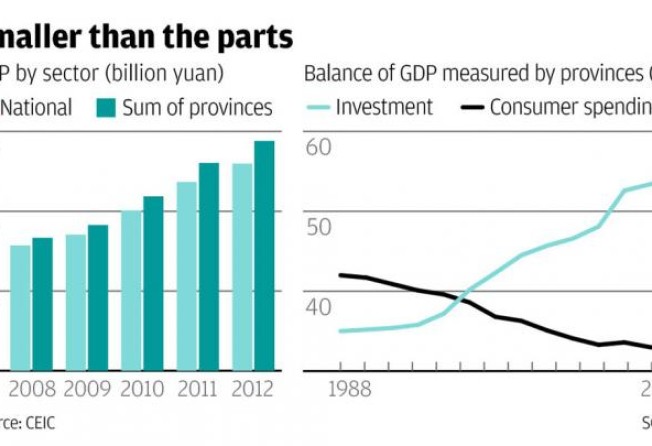
Province-sized hole in GDP figures from Beijing is likely to be hiding good news
The imperfections in the way the mainland's GDP figures are put together are likely to disguise how well consumer demand is doing

There has been a lot of talk recently in the mainland media about China's missing province.
It's not that someone has accidentally mislaid Gansu. The focus of attention is a province-sized hole in the mainland's national accounts.
According to Beijing's National Bureau of Statistics, the mainland's gross domestic product last year, measured by the net output of each sector, was a mighty 51.9 trillion yuan (HK$63.9 trillion).
But if you take the output figures compiled by the mainland's 31 different provinces and add them together, you come up with an even mightier 57.6 trillion yuan.
That is a discrepancy of 5.7 trillion yuan, or roughly the economic output of Guangdong, hence the talk of a missing province.
There is nothing new about disagreements between centrally and locally compiled statistics. With officials' promotion prospects determined in part by the economic performance of their fiefdoms, bureaucrats have long had a powerful reason to exaggerate local growth figures.
These days they have an additional incentive. A padded GDP figure makes it look as if the province's energy intensity - the amount of coal burned to produce each unit of economic output - is lower, earning officials extra brownie points for their environmental soundness. As a result, the GDP sum of China's parts has been greater than the whole every year now since 2002.
But difficulties with the mainland's economic statistics go far beyond exaggeration at the provincial level. The figures compiled by the central government are also deeply suspect.
One obvious indication is the speed with which Beijing announces the country's data.
The statistics bureau managed to publish whole-year 2012 GDP figures for the mainland, with all its vast and diverse economy, by January 18. Tiny, intensively measured Hong Kong will not manage to announce GDP numbers for last year until February 27.
Then there is the abiding suspicion among economists that Beijing's statisticians habitually manipulate the mainland's economy-wide inflation figures - which they do not disclose - to smooth highly volatile nominal growth numbers and ensure that the real, or inflation-adjusted, growth figures they announce accord with the central government's targets.
But perhaps the biggest problem with the mainland's statistics is the sampling method used to compile them. Despite big improvements in recent years, official statisticians still rely heavily on an old-fashioned input-output model of industrial value-added derived from the era of soviet-style central planning.
This approach is great at measuring how much you invested in building new railways or how many tonnes of pig iron your blast furnaces turned out. But it is useless at telling you how much ordinary households spent, especially on services such as housing.
This failing has led some analysts to argue that while the mainland's expenditure figures tend to overstate fixed investment, they massively understate consumer demand.
This is actually quite encouraging. National figures for 2011 showed an enormous imbalance in the mainland's economy, with fixed investment making up 46 per cent of GDP, while household consumption contributed just 35 per cent. Provincial data was even more skewed, with investment at 54 per cent of GDP and consumer spending at a paltry 33 per cent.
But the flaws in Beijing's methodology imply that the economy could be a lot less unbalanced than the official figures depict, with consumer spending actually making up a far greater proportion of economic activity; closer to half.
If this is the case, it means the task of economic rebalancing facing the new leadership should be much easier than anyone dares hope, and that the only missing province in China is the one where they compile accurate statistics.